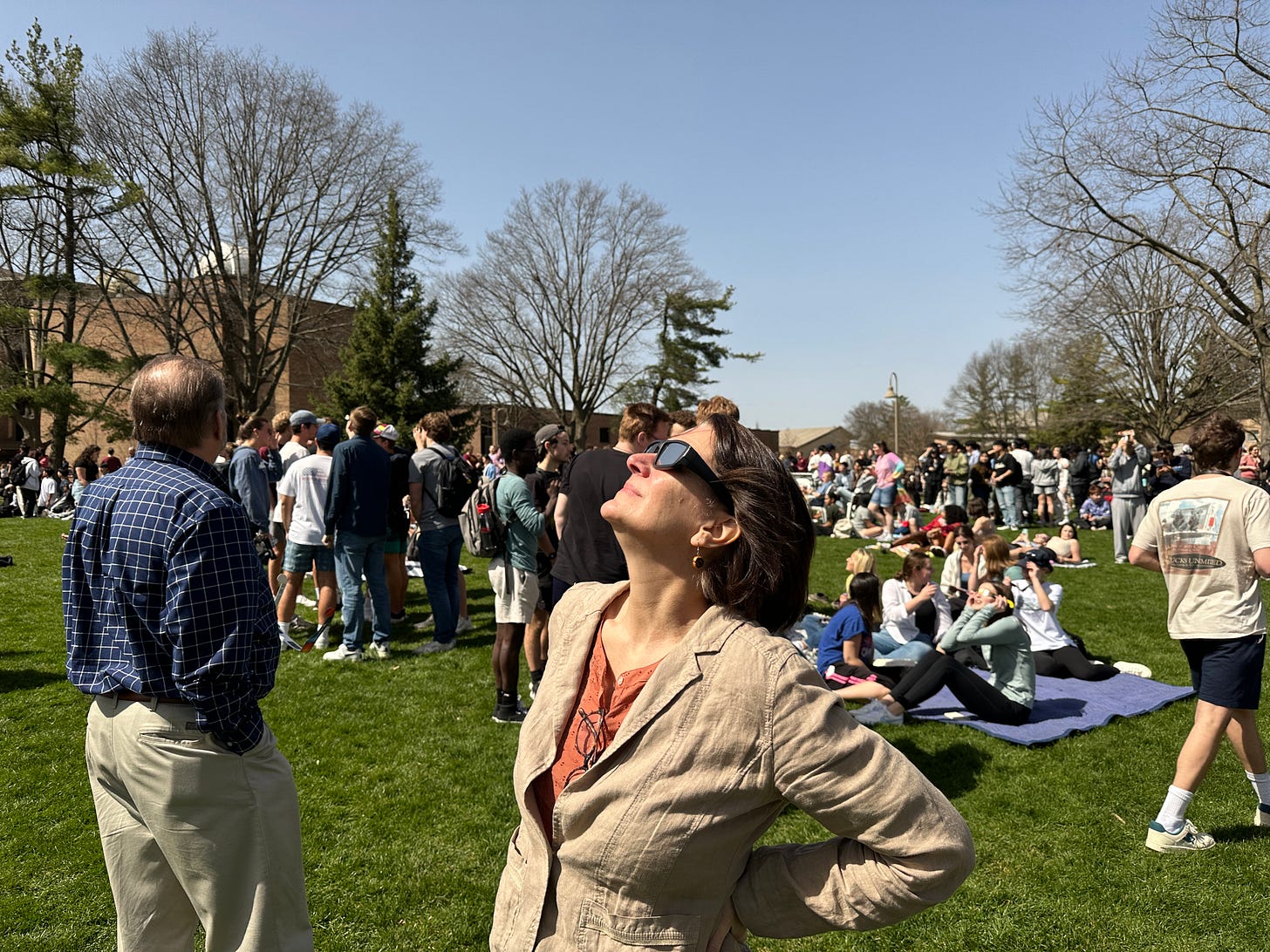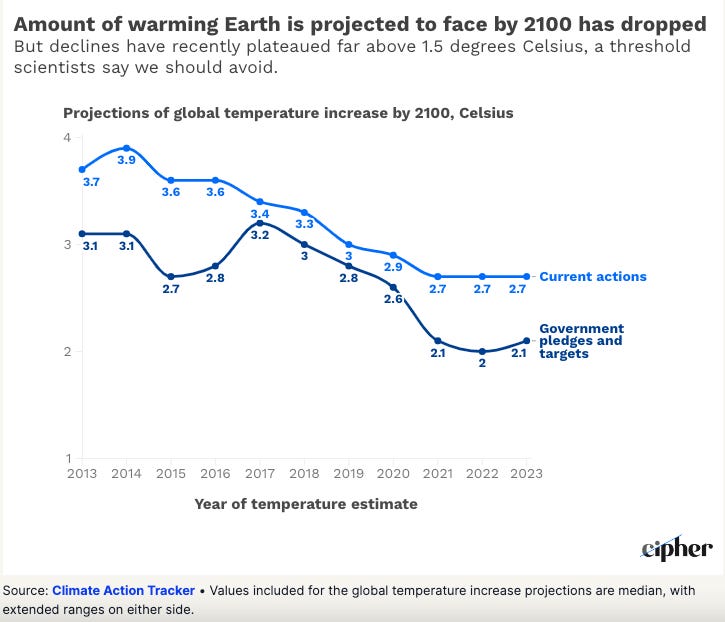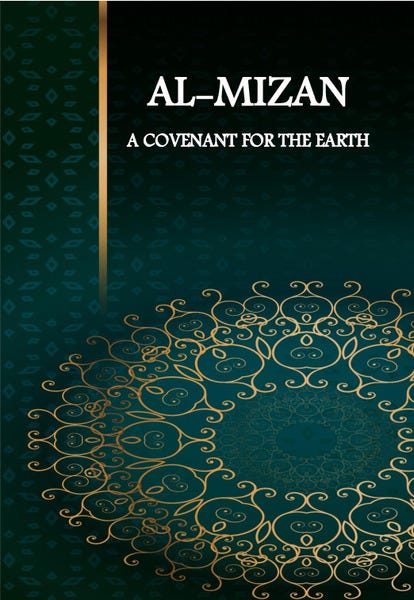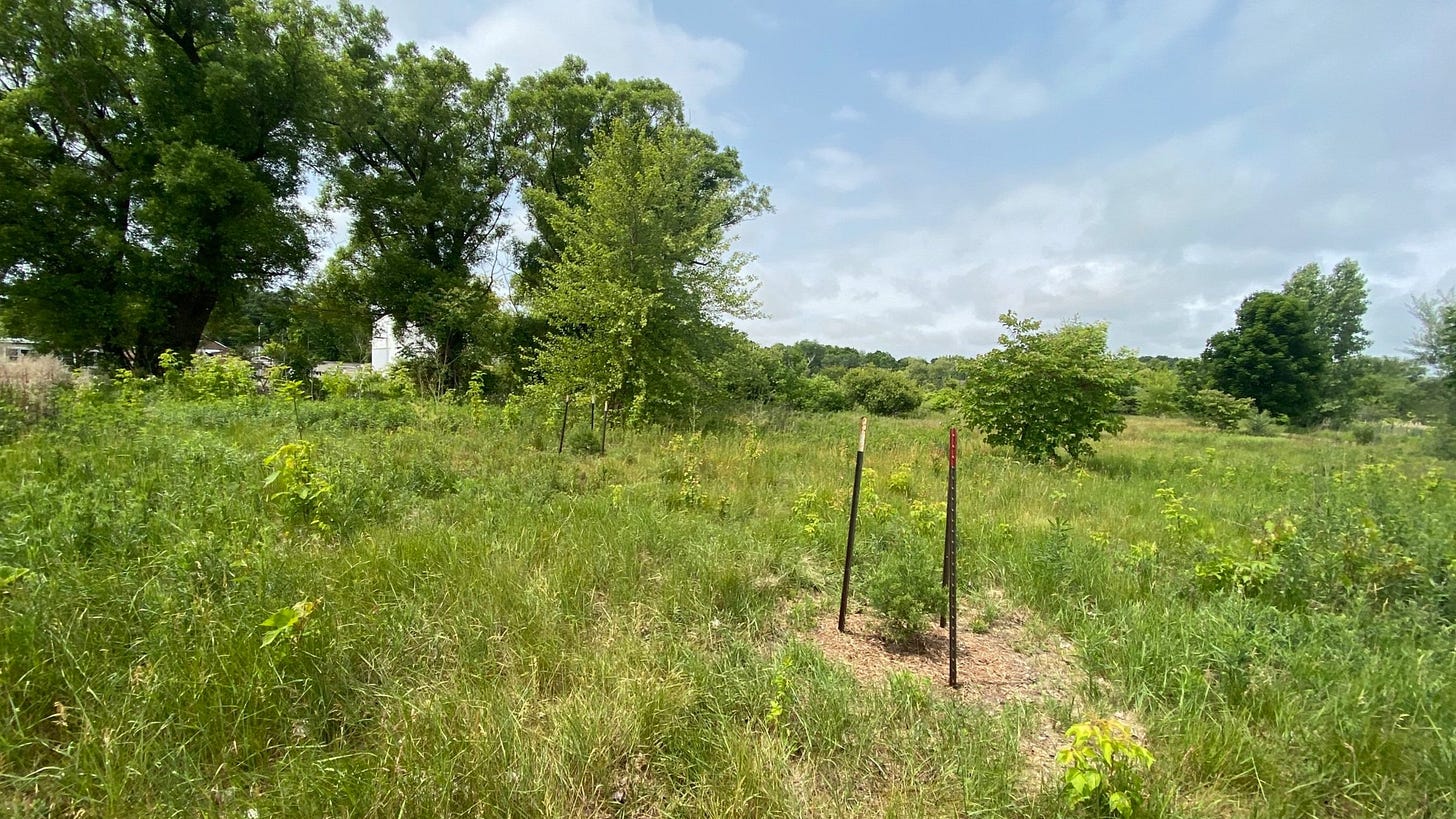Refugia Newsletter #66
Earth Day stocktaking, Muslim climate statement, a church redeeming land while running fast
Refugia News
Happy Earth Month! I hope you have found some meaningful way to celebrate our beautiful planet this month, perhaps with some form of activism, or perhaps simply by relishing some local place or creature that you love. I’ve noticed a robin nesting on top of a downspout at my house, so I say hi to her (quietly) every morning. And my native plantings are sprouting madly again—good job, plants!
One of my soon-to-retire colleagues was cleaning out his office (all of us English professors do tend to hoard books…) and he found this little gem on his shelf, which he passed along to me. It’s a thick, yellowing paperback that was produced for the first Earth Day in 1970 to support the “teach-in” that was organized on university campuses.
Fascinating little time capsule. I noted this sentence in the Foreword:
Only the young seemed to feel any sense of urgency—for inaction now means they will watch this world being destroyed.
Yikes. This was before we really understood the threat of climate change! The concerns at the time were mostly about pollution and ecosystem destruction—serious concerns then and still now, of course. Today, the threats are even more extensive and existential, global awareness and concern grow daily, and the young are still carrying a lamentable burden—and also still leading the way.
EarthDay.org has a very nice website that outlines the history of the event. According to this website, the first Earth Day “inspired 20 million Americans — at the time, 10% of the total population of the United States — to take to the streets, parks and auditoriums to demonstrate against the impacts of 150 years of industrial development which had left a growing legacy of serious human health impacts.”
In honor of Earth Day, we’ll do a little stock-taking in a minute.
First, I invite you to be inspired by my friend Kyle Meyaard-Schaap, who presented a cracking talk on Christian activism on climate last week. I was on the panel of respondents for his talk, which was the last installment of the New Brunswick Theological Seminary’s Creation Care series. You can view the video here.
Also, real quick: I am sorry to report that I made a few boo-boos in my last newsletter, in particular with crediting some of the artwork featured. My apologies. That’s what I get for trying to produce a newsletter during a major book festival. I received very kind notes on the boo-boos, and the official version of the issue that lives permanently on Substack is now entirely correct. (I hope!)
Watching the eclipse on a college campus on April 8: super fun. Students were out in force, duly equipped with their special glasses. There I am enjoying the moment—we had the perfect day for viewing and 94% totality.
This Week in Climate News
As promised, a wee stock-take for Earth Day. I refer you to this excellent interview with Dr. Katharine Hayhoe by Sam Matey—both excellent climate communicators who work hard to counter doom and gloom in the media with factual communication that gives us a fuller picture.
This graphic, from Our World in Data, sums things up nicely.
Image credit: Our World in Data and Sam Matey (for the caption)
Are matters serious? Yes. According to NASA, we reached 1.36C over preindustrial on average in 2023, and CO2 is at 425ppm. Meanwhile, the fossil fuel industry continues to propose and build new fossil fuel projects. Lest you feel guilty that this is all your fault because of your carbon footprint, please remember that “Just 57 fossil fuel and cement producers are linked to 80% of global fossil fuel carbon dioxide emissions since the Paris Agreement was signed in 2015.” (This is from an Axios article from April 4.)
However, look how far we’ve come in only the ten years since 2015 and the Paris Agreement! As Hayhoe outlines in the interview, and the graphic above visualizes, we could have been looking at 4-5C over preindustrial, but since 2015 we bent that curve down sharply.
We are still on track for too much warming (over 2C), and we are moving at about half the speed we need. But acceleration is still very much possible, and indeed in progress.
Are people around the world aware and concerned? Yes. More than you might think. In her Substack from March 4, Hayhoe wrote:
Hardly anyone cares about climate change… right? Wrong! New research shows that 86 percent agree that people in their country should try to fight global warming and 89 percent say they want more action from their governments. These results are based on a survey of more than 130,000 people in 125 countries around the world. [bold type original]
(For more on that research, check out this piece at Carbon Brief.)
Matey and Hayhoe, in Matey’s interview, go on to discuss the lack of coverage for important climate policy gains, the psychology of doomism, the importance of smart development for resilience, and much more.
Here’s another helpful graphic on progress so far, this one from a Cipher piece on how the energy transition is acclerating.
OK, so here’s our Our Earth Day task list:
sharply reduce greenhouse gas emissions (stop burning things for energy)
phase out fossil fuels and transition to clean energy
reverse biodiversity loss
reform land use practices and policies, including for agriculture
deal with waste, especially plastic waste
do it all fairly and justly
do it fast.
Those are the big tasks, with a million little tasks under each of those headings. Everything and everyone can help.
In other Earth Day news, this piece in TCD by Jeremiah Budin reports that “California has set a benchmark for renewable energy, with wind, solar, hydro, and geothermal supplying 100% of the state's electricity demand for 25 out of the last 32 days (and counting).” (This was April 16.) That’s a big deal. Texas is making huge progress in renewables, too. I’ll do more on how states are leading the way next time, I think.
Finally, President Biden gave an Earth Day speech in which he summed up many of the important legislative and policy advances his administration has brought about. This includes the IRA, the CHIPs Act, the Infrastructure law, renewed conservation rules, new pollution standards, and more.
He also announced two new initiatives: the Climate Corps and Solar for All. Solar for All is a $7 billion part of the IRA that
will award grants — 60 grants across the country to states, territories, Tribal governments, municipalities, and nonprofits to develop programs that enable low-income and disadvantaged communities to benefit from residential solar power.
The Climate Corps, now ready to receive applications for 2000 positions, is meant to help young people gain skills and prepare for a new workforce:
You’ll get paid to fight climate change, learning how to install those solar panels, fight wildfires, rebuild wetlands, weatherize homes, and so much more that’s going to protect the environment and build a clean energy economy.
Of course, there’s always much more to do. But let’s put one more item on our task list:
celebrate the wins.
Deeper Dive
The world’s leading Islamic organizations have gotten together to produce a new document that urges Muslims worldwide to address climate change as a way of living out their faith. You mean, like, a Muslim version of Pope Francis’s 2015 Laudato si’? Exactly.
The document was released Feb. 27 at the United Nations Environment Assembly in Nairobi. I read about the event in an article in The Christian Century, which reprinted this piece by Frederick Nzwili of Religions News Service. The new document is called Al-Mizan: A Covenant for the Earth. Intrigued, I clicked around, found it online, and read it myself.
Fascinating! I’ve met Muslim climate activists before, but I’ve never read a deep dive into Muslim thinking about the relationships among the divine, humans, and the earth. What struck me first was the very clear resonance of this document both with science and with Laudato si’. Al-Mizan sums up our current crisis right in line with current science and also insists on some big principles that fit with Christian thinking, too: God created this world, all parts of it are inherently valuable, humans are accountable to God for how they treat this world, we have messed up badly, and people of faith need to get with it. Obviously, that’s a rough summary, not a quote!
Al-Mizan means “dynamic equilibrium” or “balance,” a fundamental Muslim concept: “The cosmic balance or equilibrium is associated in the Qur’an with al-qist: equity, fairness, and justice.” This is the foundational principle on which the moral reasoning of the document rests.
I was impressed with the emphasis in the document on justice and equity. The authors were not afraid to critique wealth inequality and greed, including for ordinary people: “Our aspiration to be middle-class consumers is taking precedence over living in harmony with nature.” The document contains sharp critiques of the recent COP summary agreement as not strong enough, our obsession with private property, wealth accumulation by charging interest, industrial agriculture, and more.
It was interesting to see the same kind of moves that I see in comparable Christian documents: appeals to key passages of scripture, appeals to the example of key figures, a defense of science, a call to repentance, and an insistence that our faith compels us to act on behalf of people as well as planet. I learned about the strong conservation tradition that goes back to the origins of Islam. And I also noted the Muslim accent to this document, which laid great emphasis throughout on humility, reverence, compassion, self-discipline, gratitude, and doing your utmost, knowing that God is merciful.
Whatever your religious commitment, I recommend taking a look. It’s only about 60 pages of main text. If you don’t want to read the whole thing, you could start at “Annex: A Way Forward” (p. 60), which provides a concise summary.
Refugia Sighting
For our sighting today, I am bringing back my occasional feature: the three-question interview. This time, I’d like to introduce you to Rev. Dave Celesky, pastor of Unity Reformed Church in Muskegon, Michigan. Full disclosure: Dave is one my doctoral students at Western Theological Seminary—part of the “Refugia Church” cohort I’m leading with hubby Rev. Dr. Ron Rienstra.
Dave has come up with a brilliant project for his doctoral thesis: buying and “redeeming” land as a congregational project. Dave has created an organization called Redeem Mi Land (Mi, as in Michigan), and he and his church are working on the first piece of land themselves. Dave describes the land on the website:
This piece of land, smaller than an acre, is located along the Montague-Hart Rail Trail…it is a stone’s throw from the White River, it is in eyesight of a public park, a city campground, a nice gazebo, and it is also a dump.
Image credit: redeemmiland.org
That’s right. Under what looks like an OK place is a pile of garbage that was sodded over by the city. You can read the history of this land here. Dave is working with his congregation to dig up the garbage, clean it up, and replant the land with appropriate native plants.
A ton of work? Yes, but not only is the land going to be a proper refugia, Dave and his church are also building community partnerships—with other churches, the DNR, businesses, the city, and more. They are building a resilient social fabric of neighbors, so that the church is one node in a whole refugia network.
How are they funding all this? Aha. That’s another genius part of Dave’s scheme. Among other strategies, they’re doing a fund run! Making that happen is also building community partnerships and connections. Genius. The half-marathon/5K is happening next weekend, May 4. In case you’re wondering: yes, Dave is a runner, and yes, Dave is a Stars Wars fan. May the Fourth be with you, Dave!
Here’s my interview with Dave.
DR (me): Tell us about how planning the fundraiser run has created connections in the community.
DC (Dave): This has probably been the easiest part of planning the run. I find that Michiganders are eager to connect with one another when given the opportunity. The race course itself is a weird Venn Diagram of three separate civic entities: the City of Montague, the Township of Montague, and the Michigan Department of Natural Resources. At each level of work and institution there are good people at the heart of it. Everyone who has been a part of the planning has been warmly welcoming and excited to connect me with the next person that I didn’t know. Phrases like “you gotta talk to so-and-so, they’d love this!” were common and a lot of my communications started out with things like “You don’t know me, but so-and-so gave me your number.” Local businesses, especially those closest to the land itself, have seen this as a great touch point for their community.
It’s our first race, hasn’t even happened yet, and we are already being asked about next year. There have been a number of local people who have found out through word of mouth, and have taken the initiative themselves to contact Redeem Mi Land, just to let us know that they support what’s happening.
DR: What have been the most difficult challenges so far, practically speaking, in restoring this piece of land?
DC: One of the biggest challenges has been to show people that this particular piece of land is actually in need of help. On the surface it actually looks fine, just a little scrubby. It’s below the surface that the real issue dwells. Year ago it was part of a town civic dump, and when the city wanted it to be alongside a tourist area they simply tamped it down and put grass over the top of it. Helping people to see beyond the surface level has had its challenges.
Another challenge is funding. Redeem Mi Land was very recently granted 501(c)3 status, and that will help to open some doors, but we exist in an odd space. Redeem Mi Land is based in the Christian faith, and we don’t try to hide that, so there are a number of grants and funding that are “off the table” because of the religious aspect.
Ironically, in the church, because Redeem Mi Land is environmentally focused there are a number of folks who see this kind of work as left-leaning, liberal, fluffy stuff and they have trouble connecting it with their personal faith (and tied to that is their donations). Redeem Mi Land is very new, and I am confident that given enough time we will find our supporters both in the church and in the State of Michigan.
DR: How do you connect land restoration with refugia and with the role of your church in the community?
DC: The biggest connection we can make is telling a story, and it’s a story with layers. We can start with the story of the land itself, its history and use (often ab-use), and the people who have called it home, continue to call it home, and will call it home in the future. This part of the story is very factual and measurable, we can say x number of acres were polluted, but then cleaned. We can say we planted x number of seedlings and removed x pounds of waste, and all of this was done over x number of days with x number of people. Those facts alone are a sufficient story for a newspaper or essay. They can make the participants feel like they’ve achieved some good in their slice of the world.
The wider and deeper layer of the story is what Redeem Mi Land is intended to focus on. In land restoration we see a wonderful parable about what redemption is like. Redemption for the land looks like redemption for humans in Jesus Christ. The land we redeem is bearing some burden; it’s polluted, neglected, abandoned, etc. For our metaphor we’ll say that it bears the burden of sin (and really, the stuff we’ve done to land is sinful).
The land bears this burden and cannot cleanse itself on its own; it needs someone, a ‘redeemer’ to remove the burden. In this case, the local church acts as redeemer, initiating the saving and restoring of the land as the hands and feet of Christ. This redemption, just like in our own lives, is not a quick clean-up. It’s not an overnight, well-now-you-are-all-better, off-you-go kind of thing. It’s a lifelong endeavor.
So Redeem Mi Land aims to make sure that the local church and local community continue to care and nurture that land over the generations that come. Will it ever perfectly resemble what it was created to be? Probably not, truthfully, not until New Heaven/New Earth, but isn’t that the same with our own redemption, too?
DR: Thanks so much, Dave!
That’s all for this week. Until next time, be well.










